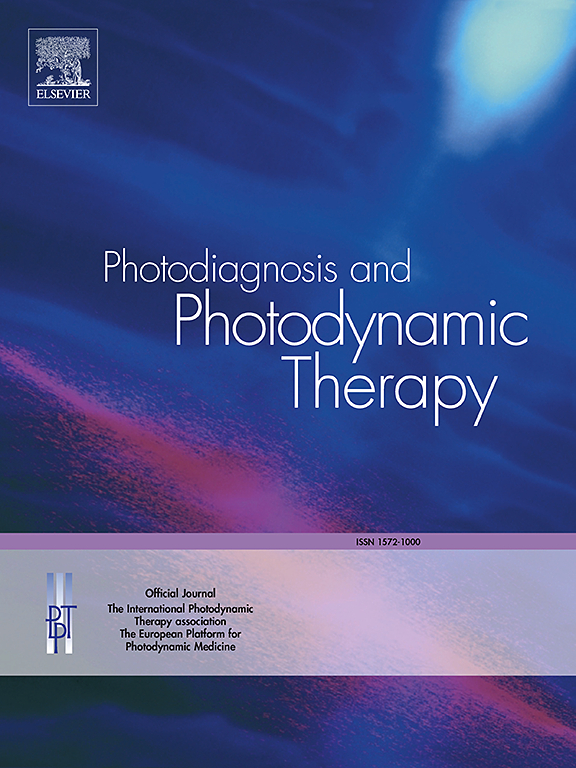Synergistic effect of photobiomodulation and leukocyte-platelet rich fibrin on bone regeneration in rat critical defects
IF 2.6
3区 医学
Q2 ONCOLOGY
引用次数: 0
Abstract
Objective
This study aimed to evaluate the effects of leukocyte and platelet-rich fibrin (LPRF) and LPRF combined with photobiomodulation therapy (PBMT/LPRF) on bone regeneration in critical-sized defects.
Materials and Methods
Forty-six male Wistar rats, weighing 200 ± 20 g, aged 9 weeks ± 2, were randomly assigned to four groups: (1) bone material with normal saline referred to as Control, (2) bone material with LPRF, referred to as BL, (3) bone material with LPRF and PBMT referred to as BLP, and (4) bone material with normal saline and PBMT referred to as BP. Bone defects of 8 mm were created in the calvaria using a trephine bur under anesthesia. Bone graft material mixed with normal saline or LPRF was applied to the defect sites, followed by coverage with a collagen membrane. The PBMT groups received laser treatment (WL:810 nm, Irradiation mode: CW,P:200 mW, ED:8 J/cm², Spot size:0.5 cm², Total dose:96 J/cm²) . All groups were evaluated after 30 days for histological analysis of bone regeneration, inflammatory response and soft tissue healing.
Results
The study included forty-six subjects across four groups: BLP (23.9%), BL (23.9%), Control (26.1%), and BP (26.1%). Connective tissue analysis revealed that BL and BLP groups had 81.8% loose connective tissue, while the Control group had 91.7% loose connective tissue and 8.3% fibrosis. Moreover, the BP group had 58.3% of subjects showing loose connective tissue, 33.3% forming granulation tissue, and 8.3% developing fibrosis. Additionally, in the BP group, other tissues such as normal connective tissue were also present, though in smaller proportions. In terms of scaffold remaining and new bone generation, the BL group had 45.45% (SD = 22.67) scaffold and 7.29% (SD = 2.77) new bone. The BLP group showed higher scaffold remaining (46.09%, SD = 17.91) and significantly more new bone (16.61%, SD = 9.08). The Control group had a scaffold remaining of 54.21% (SD = 21.41) and new bone generation of 6.84% (SD = 2.32). The BP group exhibited the highest scaffold remaining (61.03%, SD = 15.13) but lower new bone generation (6.73%, SD = 2.77). Moreover, the groups receiving PBMT exhibited enhanced and accelerated soft tissue healing during the initial three weeks.
Conclusion
Results of the present study proved that PBMT with LPRF expresses significant bone regeneration in critical-sized defects than each treatment performed separately when compared to those from the control group, however, this benefit needs to be confirmed with larger sample sizes and longer follow-ups.
光生物调节与富白细胞-血小板纤维蛋白对大鼠重度缺损骨再生的协同作用。
目的:本研究旨在评价富白细胞和血小板纤维蛋白(LPRF)及LPRF联合光生物调节治疗(PBMT/LPRF)对临界尺寸缺损骨再生的影响。材料与方法:雄性Wistar大鼠46只,体重200±20 g, 9周龄±2岁,随机分为4组:(1)骨材料加生理盐水(Control),(2)骨材料加LPRF (BL),(3)骨材料加LPRF (BLP),(4)骨材料加生理盐水(BP)。在麻醉状态下,使用环钻在颅骨内形成8mm的骨缺损。骨移植材料与生理盐水或LPRF混合应用于缺损部位,然后用胶原膜覆盖。PBMT组接受激光治疗(WL:810 nm,照射模式:CW,P:200 mW, ED:8 J/cm²,光斑大小:0.5 cm²,总剂量:96 J/cm²)。30 d后对各组进行骨再生、炎症反应和软组织愈合的组织学分析。结果:共纳入4组46例患者,分别为:BLP(23.9%)、BL(23.9%)、Control(26.1%)和BP(26.1%)。结缔组织分析显示,BL组和BLP组结缔组织疏松率为81.8%,对照组结缔组织疏松率为91.7%,纤维化率为8.3%。此外,BP组58.3%的受试者出现疏松结缔组织,33.3%形成肉芽组织,8.3%发生纤维化。此外,在BP组中,其他组织如正常结缔组织也存在,尽管比例较小。支架残留及新骨生成方面,BL组支架保留率为45.45% (SD = 22.67),新骨生成率为7.29% (SD = 2.77)。BLP组支架剩余率较高(46.09%,SD = 17.91),新骨明显增多(16.61%,SD = 9.08)。对照组支架剩余54.21% (SD = 21.41),新骨生成6.84% (SD = 2.32)。BP组支架剩余量最高(61.03%,SD = 15.13),新骨生成量较低(6.73%,SD = 2.77)。此外,在最初的三周内,接受PBMT治疗的组表现出增强和加速的软组织愈合。结论:本研究结果证明,与对照组相比,PBMT联合LPRF在临界尺寸缺陷中比单独进行的每一种治疗都表现出显著的骨再生,然而,这种益处需要通过更大的样本量和更长的随访来证实。
本文章由计算机程序翻译,如有差异,请以英文原文为准。
求助全文
约1分钟内获得全文
求助全文
来源期刊

Photodiagnosis and Photodynamic Therapy
ONCOLOGY-
CiteScore
5.80
自引率
24.20%
发文量
509
审稿时长
50 days
期刊介绍:
Photodiagnosis and Photodynamic Therapy is an international journal for the dissemination of scientific knowledge and clinical developments of Photodiagnosis and Photodynamic Therapy in all medical specialties. The journal publishes original articles, review articles, case presentations, "how-to-do-it" articles, Letters to the Editor, short communications and relevant images with short descriptions. All submitted material is subject to a strict peer-review process.
 求助内容:
求助内容: 应助结果提醒方式:
应助结果提醒方式:


